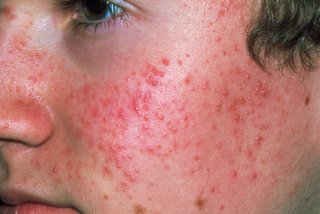Acne is a common skin condition that affects most people at some stage in their lives.
You are most likely to get acne on your:
- face
- back
- chest

Symptoms of acne
Acne causes spots and oily skin. Sometimes it can cause skin that's hot or sore to touch.
Types of acne spots
There are 6 main types of spot caused by acne:
Blackheads
Blackheads are small black or yellowish bumps that you can get on your skin. They're not filled with dirt. Their colour comes from the inside of a tiny hole in the skin which has become blocked.
Whiteheads
Whiteheads look like blackheads, but may be firmer and do not empty when squeezed.
Papules
Papules are small red bumps that may feel tender or sore.
Pustules
Pustules are like papules but have a white tip in the middle. A build-up of pus causes them.
Nodules
Nodules are large hard lumps. They build up under your skin and can be painful.
Cysts
Cysts are large pus-filled lumps. They look like boils. If you have these, you are at more risk of getting permanent scarring.
Different levels of acne symptoms
You can have different types of spots depending on how bad your acne is.
Mild acne
You have mild acne when you have whiteheads and blackheads, with a few papules and pustules
Moderate acne
When you have more whiteheads and blackheads, with many papules and pustules you have moderate acne.
Severe acne
Severe acne is when you have sore papules, pustules, nodules or cysts. You might also have some acne scarring. This happens when spots burst and damage your skin.
Who can get acne
Acne is very common in teenagers and younger adults. About 8 in 10 people age 11 to 30 get acne.
Acne is most common in girls age 14 to 17, and in boys age 16 to 19.
Most people have acne on and off for a few years before their symptoms start to get better as they get older. Acne often goes away when a person is in their mid-20s.
In some cases, people keep on getting acne as adults. Other people can start getting it when they are adults. About 1 in 20 women and 1 in 100 men have acne over the age of 25.
Diagnosing acne
If you have mild symptoms you can ask your pharmacist for advice.
Your treatment will depend on the type of acne you have.
Your GP can tell you if you have acne by looking at your skin.
They will look for the different types of spot, such as blackheads or sore, red nodules.
